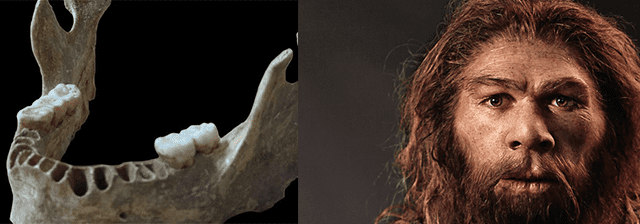DNA analysis of the jawbone of a human who lived in modern day Romania some 40,000 years ago has the most Neanderthal ancestry ever seen. Up to 9% of the ancient man’s DNA was Neanderthal, suggesting interbreeding occurred much earlier than previously thought. In fact, this European human had a Neanderthal ancestor four to six generations back in his family tree. How would it be to have a Neanderthal for a great-great-great-grandfather?

Most people living outside sub-Saharan Africa today have about 1 to 3 percent Neanderthal DNA. The study published today by a team of international researchers suggests, however, that the ancient Romanian’s genome contained 6 to 9% Neanderthal genes, as reported in Nature. Neanderthals lived in Europe until about 35,000 years ago, disappearing at the same time modern humans were spreading across the continent.
The jawbone was found in 2002 along with the skull of another individual in a cave in Romania called Pestera cu Oase. There were no artifacts found nearby, no clues that could indicate some cultural trademark to help identify who the individuals were or how they lived. From the start, the researchers knew there was something special to the jawbone, though. It predominantly had physical features resembling those of modern humans, but there were some uncanny Neanderthal traits that were also apparent. Radiocarbon dating determined the jawbone was between 37,000 and 42,000 years old.
David Reich at Harvard Medical School and Svante Pääbo at the Max Planck Institute in Germany then got involved and performed the genome sequencing.
“Some Neanderthals clearly became incorporated in modern human societies,” said Pääbo, director of the Department of Evolutionary Genetics at the Max Planck Institute for Evolutionary Anthropology. “It is still unclear exactly how much of the complete Neanderthal genome exists today in people, but it seems to approach something like 40 percent.”
“But, of course, the Neanderthals are clearly extinct in the sense that they do not exist as an independent, separate group since some 30,000 or 40,000 years.”
“The sample is more closely related to Neanderthals than any other modern human we’ve ever looked at before,” Reich says.
“It’s an incredibly unexpected thing,” Reich says. “In the last few years, we’ve documented interbreeding between Neanderthals and modern humans, but we never thought we’d be so lucky to find someone so close to that event.”
Interesting enough, the Oase individual didn’t pass his Neanderthal ancestry to the present population, according to Reich.
“This sample, despite being in Romania, doesn’t yet look like Europeans today,” he says. “It is evidence of an initial modern human occupation of Europe that didn’t give rise to the later population. There may have been a pioneering group of modern humans that got to Europe, but was later replaced by other groups.”






